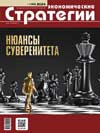Global Reset of Russia’s Sociocultural Trend: from “Classical” to “New” Eurasianism
DOI: 10.33917/es-1.193.2024.86-89
The article identifies dynamics of the Eurasian concept, which is considered as the basic strategy for the positive development of Russia’s foreseeable future. The author shows that over the last century the national Eurasian model has been transformed in the process of actual socio-economic and political-ideological attitudes. Within classical eurasianism Russia is viewed as a special geographical and socio-cultural civilization that combines Western (Western European) and Eastern (Asian) stereotypes.
It is proved that in the process of the USSR development and formation of the “new” Russia, the theory of eurasianism with a Western European trend was being implemented. Since the second decade of the 21st century, in order to overcome the consequences of anti-Russian sanctions, the Russian Federation has been stimulating a national strategy of Eurasianism with an Eastern (Asian) orientation. However, by the middle of the 21st century in implementing the conceptual model of Eurasianism Russia will return, as suggested in the article, to a classical strategy based on a balance of Westernization and Orientalist ideas.
References:
1. Blekher L.I., Lyubarskiy G.Yu. Glavnyy russkiy spor: ot zapadnikov i slavyanofilov do globalizma i Novogo Srednevekov’ya [The Main Russian Dispute: from Westerners and Slavophiles to Globalism and the New Middle Ages]. Moscow, Akademicheskiy proekt, 2003, 608 p.
2. Chumakov A.N. “Filosofskiy parokhod”. 100 let bez pokayaniya [“The Philosophical Ship”. 100 years without Repentance]. Monografiya. Moscow, Prospekt, 2022, 456 p.
3. Zalozhnykh Yu.S. Slavyanofily i neoslavyanofily: problema soderzhaniya kategoriy v dukhovnoy praktike rossiyskogo obshchestva [Slavophiles and Slavophiles: the Problem of the Content of Categories in the Spiritual Practice of Russian Society]. Filosofiya i kul’tura, 2013, no 9, pp. 1212–1216.
4. Berdyaev N.A. Evraziytsy. Russkoe natsional’noe samosoznanie i “evraziystvo” [Eurasians. Russian National Identity and “Eurasianism”]. Moscow, T8, 2018.
5. Iskhod k Vostoku. Predchuvstviya i sversheniya [Exodus to the East. Premonitions and Accomplishments]. Pod red. P.N. Savitskogo, P.P. Suvchinskogo, N.S. Trubetskogo, G.V. Florovskogo. Sofiya, 1921.
6. Osnovy evraziystva [Foundations of Eurasianism]. Moscow, Arktogeya Tsentr, 2002, 800 p.
7. Lyuks L. Zametki o “revolyutsionno-traditsionalistskoy” kul’turnoy modeli “evraziytsev” [Notes on the “Revolutionary-Traditionalist” Cultural Model of the “Eurasians”]. Voprosy filosofii, 2003, no 7, pp. 23–34.
8. Shpotov B.M. Zapadnye istochniki industrializatsii SSSR (konets 1920-kh — 1930-e gody) [Western Sources of Industrialization of the USSR (late 1920s —1930s)]. Moscow, Institut vseobshchey istorii RAN.
9. Sipols V.Ya. Torgovo-ekonomicheskie otnosheniya mezhdu SSSR i Germaniey v 1939–1941 gg. v svete novykh arkhivnykh dokumentov [Trade and Economic Relations between the USSR and Germany in 1939–1941. in the Light of New Archival Documents]. Novaya i noveyshaya istoriya, 1997, no 2, pp. 29–41.



